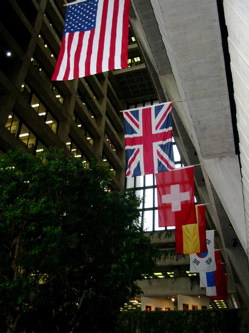Physicists in the US have devised a new way of making very precise measurements of gravity by bouncing atoms up and down off a laser beam. Unlike comparable techniques that involve dropping atoms about 10 cm, this new method only needs a drop of about 20 µm. The team has also modified the experiment to perform atom interferometry, whereby quantum interference between atoms can be used to measure tiny accelerations.
Because of its compact size, the team believes the technique could be used to make precise accelerometers that could be used in navigation systems for aircraft, submarines and even spacecraft. The technique may also find use in experiments that look for deviations from Newton’s laws of gravitation.
Over the past two decades physicists have become adept at trapping and manipulating small numbers of atoms using lasers and electromagnetic fields. Like all matter, these atoms fall towards Earth, which has allowed scientists to make very precise measurements of how the gravitational force acts on very small objects and over relatively short distances.
10,000 ultracold atoms
The new bouncing technique was developed by Cass Sackett and colleagues at the University of Virginia in the US, who begin their experiment with a collection of about 10,000 rubidium-87 atoms cooled to micro-Kelvin temperatures. Using such ultracold atoms is important because they have little thermal energy and therefore are nearly motionless when they begin to fall within a vacuum chamber (arXiv:0902.0109).
Initially held up by a magnetic field, the atoms fall when the field is switched off. As they drop down, most of the atoms collide with photons emitted by a laser diode placed directly under the trap, which emits pulses of light in an upwards direction about once every 2 ms. When the atoms collide, they each receive a precise amount of momentum, which knocks them back up. These atoms then fall down again, only to collide with the next laser pulse.
If the colour of the laser light and the frequency of pulses are set correctly, the atoms will be set bouncing and the acceleration due to gravity can be deduced from the experimental parameters and Planck’s constant. The team managed to sustain this bouncing for about 100 cycles, which they say is the equivalent of dropping the atoms about 2 cm in a standard experiment. After correcting for the effect of stray magnetic fields on the atomic spins, the team obtained a gravitational constant of 9.814 ± 0.008 m/s2, which agrees with the expected value.
“Our technique provides a way to apply an extremely well-known force to the atoms”, explained Sackett. “By knowing the force needed to balance gravity, we get a precise measurement of gravity”, he added.
Stanford University’s Mark Kasevich, who pioneered the use of ultracold atoms to measure gravity, told physicsworld.com. “It’s a nice paper — it certainly indicates that it would be interesting to do follow up experiments to push the limits of sensitivity.”
Room for improvement
Sackett told physicsworld.com that the team plans to improve the precision of the method by preparing the atoms in a state that is not as sensitive to magnetic fields. The team also plans to reduce the number of atoms that are lost to the experiment — currently about 0.1% per bounce. Sackett believes this can be done by improving their control of the intensity of the laser pulses.
The team has also worked out a way to use bouncing atoms to do atom interferometry. If atoms are sent along different paths and then combined at a detector, the resulting interference pattern depends on any differences in the accelerations experienced by the atoms. If built into a portable device, such accelerometers could be used as part of highly-accurate navigation devices that could work independently of GPS systems — making them attractive for submarine and other military applications.
To do atom interferometry, the team takes a slightly different approach and use laser pulses to split the atoms into two different groups, which are then independently bounced for many cycles before being recombined. The resulting interference pattern depends on any differences in the accelerations experienced by the atoms.
Although this technique gave a less precise value for gravitational acceleration than just bouncing, the team believe that they can improve the precision by about a factor of ten. If built into a portable device, such accelerometers could be used as part of highly-accurate navigation devices that could work independently of GPS systems — making them attractive for submarine and other military applications.
Slight imbalance
With regards to the interferometer, the current scheme is limited by a slight imbalance between the forces on the two groups of atoms — and Sackett says that improving this is possible, but will be difficult.
Sackett believes that an early application of the technology could be in navigation aids for military vehicles, vessels and aircraft. Such a device would keep track of its position by monitoring its acceleration — without the need of a GPS signal, which could be jammed.
Such devices could also be used in oil and mineral exploration, says Sackett, because they would be small enough to lower into bore holes to measure the mass density of the earth as a function of depth.
In the future, Sackett believes that the technique could be used to make very precise measurements of gravity over very short length scales — which could reveal deviations from Newton’s law as predicted by some theories of particle physics. However, he cautions that even bouncing over a few micrometres could be too great a distance for such measurements.

